Rifa-e-Aam Club

The Rifa-e-Aam Club (Urdu: رفاہِ عام کلب, Hindi: रिफ़ा-ए-आम क्लब) is a historic building in Lucknow, India. It is best known as the place where the Progressive Writers Movement was created.[1][2]
History[edit]
The building was constructed around 1860 by the Nawab of Awadh, who intended it to be a centre of the royalty's literary life in the region.[1][3] According to a local historian, the name derived from "rifa" or "happiness" and "aam" or "common", and suggested that the club offered happiness to the common man.[4][5] The club was open to everybody, in contrast to European clubs which did not allow Indians to apply.[5] In subsequent years it became what The Economist described as "an important nationalist hangout".[6] It was one of the centres of Indian nationalism and other intellectual activity, frequented by individuals such as Munshi Premchand and Mohammad Amir Ahmad Khan.[2] In the 1900s it hosted meetings of the All-India Muslim League.[1] The club hosted a meeting of the Indian National Congress and the Muslim League which led to the Lucknow Pact of 1916, which was also signed on the premises.[3][2] Mahatma Gandhi visited the building to give a speech on Hindu-Muslim unity on 15 October 1920[2][7][8] and on 26 April 1922 Jawaharlal Nehru and Vallabhbhai Patel made speeches at the club encouraging local people to intensify the Swadeshi movement.[9] The Progressive Writers Movement was created on 10 April 1936.[1]
The building has not been well maintained in the decades since; one wing has become a hospital, another has been abandoned, and the courtyard is a rubbish dump.[6][1][3] The poor state of the building has led to local activism trying to get it recognized and protected as a heritage landmark by the government.[2][1][6][5]
References[edit]
- ^ a b c d e f "Rifa-e-aam – Progressive Writing, Regressive Caretaking". The Lucknow Observer. 5 August 2015. Retrieved 28 November 2016.
- ^ a b c d e "Rifa-e-Aam: From literary riches to rag-pickers' hub". The Times of India. Retrieved 23 November 2016.
- ^ a b c Rizvi, Uzair Hasan. "A century on, the site of the historic Lucknow Pact is in ruins". Scroll.in. Retrieved 23 November 2016.
- ^ "Children draw attention to crumbling heritage building". The Hindustan Times. 24 April 2015. Retrieved 24 November 2016.
- ^ a b c "Kids move city to save Rifa-e-Aam club". The Times of India. Retrieved 23 November 2016.
- ^ a b c "Brick by brick". The Economist. 22 October 2016. ISSN 0013-0613. Retrieved 23 November 2016.
- ^ "Mahatma's Speeches Stressed On Harmony And Cleanliness « Tornos India". www.tornosindia.com. Archived from the original on 24 November 2016. Retrieved 24 November 2016.
- ^ Husain, Yusra (2 October 2016). "Battered with age, for this house Gandhi's dream is still alive". The Times of India. Retrieved 24 November 2016.
- ^ Sharda, Shailvee (13 November 2014). "Lucknow in the life of Nehru". The Times of India. Retrieved 24 November 2016.
